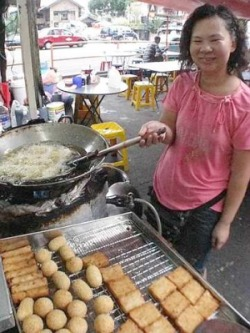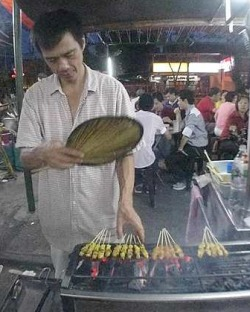A treasure trove of street food can be found at Air Itam in Penang, and prices are still very reasonable.
WHEN I was a child, longer ago than I care to remember, my brother and I would sometimes be lucky enough to be taken to a “proper” toy shop by some kind relative who wanted to give us a present.
This would be such a treat (pasar malam toys were what I usually got) that I would stand at the entrance with my eyes wide open and my chin down to my chest in stupefied awe: all these wonderful dolls and masak-masak sets, and I could go through and pick the one I wanted!
I feel a bit like this the other night when I go to research the promised Part II of my “Air Itam” (Black Water) food articles: all this wonderful food, and stomach space notwithstanding, all mine for the trying!
It’s a typical old-fashioned hawker chiew jang khar (“the place around some big trees with portruding roots”) place which has been going for over four decades. Stretching from the Reservoir Garden kopitiam (coffeeshop) opposite the Public Bank building on Jalan Air Itam and continuing right through to the corner of the Air Putih (White Water – ah such constrasting names) Road, the motley collection of some 65 stalls lines both sides of the inner road. You can order from any stall and eat inside one of the four kopitiams or alfresco at the many tables placed outside.
There are so many stalls and it’s safe to say that whatever you wish to eat – within reason, of course – is probably available.
They serve an eclectic range of food. Local Penang favourites such as o chien oyster omelettes, economy mixed rice and roti canai are here along with an assortment of noodles: char kuey teow, kuey teow t’ng, chee cheong fun, and assam laksa, to name but a few. Even international cuisine is available. Western steaks? Pizza? Japanese? No sweat.
As it’s warm, noisy and merry, one can get a bit hot under the collar actually. Although regulars will know which stall to order from, at first glance it can all be a bit daunting for the newcomer. Where to start?!
“Everything here is quite good,” claims Tan Boon Huat, chairman of the Air Putih Hawkers Association, “So you don’t have to worry. There will be something here to suit every taste. Many of our stalls have been here for over 40 years, and some are second generation hawkers who have taken over from their parents or uncles.”
He himself runs one of the two char hor fun (fried flat noodles) stalls; his is situated across the road from the Keat Seng Kopitiam.
“We are still very reasonably priced even though costs have gone up a lot the past few years,” he adds.
This is confirmed by Ah You a few stalls away, shrouded in smoke as he fans away at the flames under his pork and chicken satay.
“When I started selling here,” he recalls, “it was 30 sen a stick.”
A skewer now costs just 50 sen, even though consumables like the all-important charcoal have risen to RM8.50 a bag from RM2.50.
Opposite the Reservoir Garden Kopitiam (aka Or Hwa Hooi in Hokkien), Ah Hwa parks her open-backed van from which, for the past 12 years, she’s been frying her home-made chai t’au kueh (radish cake) and sesame (dough) balls filled with either crushed peanuts or tau sar.
This is not the usual street food, but is made fresh for her daily by a former dim sum chef, her husband Ah Kuey who himself dishes up hokkien mee from the same van which even self-proclaimed aficionados of the dish like myself found rather palatable.
A bit further up, Ah Lai’s tasty curry mee is slightly different from the run of the mill variety: it’s served with plenty of chilli-fried squid and, for a little extra, you can add up to 15 items ranging from hard-boiled quails’ eggs and fishballs to curried chicken wings and gizzards. His curry paste, he assures me, is home made.
I have bemoaned the gradual disappearance of local desserts like ais kacang, which many kopitiam owners find too troublesome and labour-intensive to serve, so it is a pleasure to discover that the Café Hot and Spicy still dispenses it. Their “red bean ice blended” and ai ping (literally: cold love, a light drink made with canned peaches, lychees and gelatine) are also quite refreshing.
If you prefer an even more local pudding, then head for (another) Ah You’s durian table where, in season, he displays a range of the prickly fruit from Balik Pulau (or “the back of Penang island”).
“I only sell durians from there,” he stresses, “because they are the best.” With over 30 years’ experience under his belt, he will pick just the right one for you.
The Air Itam/Air Putih hawker stalls are open every day from about 5pm to 1am, although individual stalls will shut once every two weeks. The entire place shuts down once a year – on the eve and first day of Chinese New Year.







